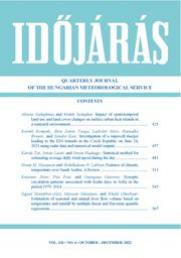Időjárás - Quarterly Journal of the Hungarian Meteorological Service (OMSZ)
Vol. 126, No. 4 * Pages 425–582 * October - December 2022
 |
|
 download [pdf: 8136 KB]
download [pdf: 8136 KB]
Impact of spatiotemporal land use and land cover changes on surface urban heat islands in a semiarid environment
Alireza Sadeghinia and Mahdi Sedaghat
DOI:10.28974/idojaras.2022.4.1 (pp. 425–455)
Alireza Sadeghinia and Mahdi Sedaghat
DOI:10.28974/idojaras.2022.4.1 (pp. 425–455)
Investigation of a supercell merger leading to the EF4 tornado in the Czech Republic on June 24, 2021 using radar data and numerical model outputs
Kornél Komjáti, Ákos János Varga, Ladislav Méri, Hajnalka Breuer, and Sándor Kun
DOI:10.28974/idojaras.2022.4.2 (pp. 457–480)
Kornél Komjáti, Ákos János Varga, Ladislav Méri, Hajnalka Breuer, and Sándor Kun
DOI:10.28974/idojaras.2022.4.2 (pp. 457–480)
Statistical method for estimating average daily wind speed during the day
Károly Tar, István Lázár, and István Hadnagy
DOI:10.28974/idojaras.2022.4.3 (pp. 481–510)
Károly Tar, István Lázár, and István Hadnagy
DOI:10.28974/idojaras.2022.4.3 (pp. 481–510)
Features of climatic temperature over Saudi Arabia: A Review
Hosny M. Hasanean and Abdulhaleem H. Labban
DOI:10.28974/idojaras.2022.4.4 (pp. 511–543)
Hosny M. Hasanean and Abdulhaleem H. Labban
DOI:10.28974/idojaras.2022.4.4 (pp. 511–543)
Synoptic circulation patterns associated with foehn days in Sofia in the period 1979–2014
Krasimir Stoev, Piia Post, and Guergana Guerova
DOI:10.28974/idojaras.2022.4.5 (pp. 545–560)
Krasimir Stoev, Piia Post, and Guergana Guerova
DOI:10.28974/idojaras.2022.4.5 (pp. 545–560)
Estimation of seasonal and annual river flow volume based on temperature and rainfall by multiple linear and Bayesian quantile regressions
Sajjad Modabber-Azizi, Meysam Salarijazi, and Khalil Ghorbani
DOI:10.28974/idojaras.2022.4.6 (pp. 567–582)
Sajjad Modabber-Azizi, Meysam Salarijazi, and Khalil Ghorbani
DOI:10.28974/idojaras.2022.4.6 (pp. 567–582)
IDŐJÁRÁS - Quarterly Journal

Az IDŐJÁRÁS a HungaroMet Nonprofit Zrt. negyedévenként megjelenő angol nyelvű folyóirata
Megrendelhető a journal.idojaras@met.hu címen.
A szerzőknek szánt útmutató itt olvasható.
Megrendelhető a journal.idojaras@met.hu címen.
A szerzőknek szánt útmutató itt olvasható.









